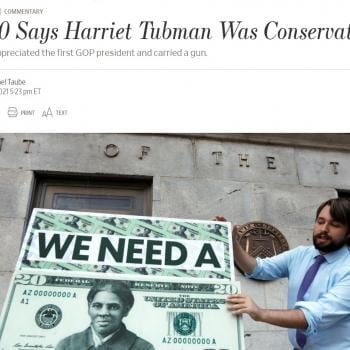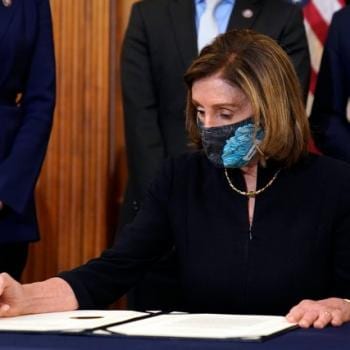A guest post by Carmen
Originally posted on facebook
There is a lot of ruckus about Hobby Lobby today, and I’ve already seen multiple sources providing inaccurate summaries about what happened. So in an effort to summarize in one place what the decision did and did not do, I decided to do the rare act (for me) of posting a Facebook note. I’ll try to provide a lot of background info so those who haven’t been following the case are brought up to speed. If you want to read the decision yourself, it is here.
The Hobby Lobby case is really two cases heard together: Burwell v. Hobby Lobby and Conestoga Wood v. Burwell. Burwell is the Secretary of the Dep’t of Health and Human Services (HHS). When you sue the government for an alleged violation of your constitutional rights, you typically name a specific official who heads the government agency or department that is doing the violation.
SCOTUS granted cert on two questions:
1) The question in Hobby Lobby was whether the birth control mandate, by compelling for-profit corporations to provide insurance coverage that includes 20 types of contraception, violates the Religious Freedom Restoration Act (RFRA). You can see the case summary here. Hobby Lobby specifically protested four types of contraception: the Mirena IUD, the Paragard IUD, Plan-B, and Ella (the last two are emergency contraceptives). The FDA has explicitly said that none of these contraceptive devices are abortifacients.
The Religious Freedom Restoration Act was passed in the early 1990s in response to another SCOTUS decision, Employment Division v. Smith. RFRA says that if the federal government passes a law of general applicability and that law imposes a burden on someone’s exercise of religion, then the government must meet the requirements of strict scrutiny analysis, which is a “test” SCOTUS typically applies when a fundamental right is being infringed.
This strict scrutiny test has two parts. First, the government must be acting to serve a “compelling interest.” Second, the government must be using the “least restrictive means” to achieve that compelling interest. This second prong is also often called the “narrowly tailored” prong. The law must be “narrowly tailored” to achieve the “compelling governmental interest.”
Congress passed RFRA because in Employment Division v. Smith, Justice Scalia—writing for the Court—stated that the government had only to meet the rational basis test when a neutral law of general applicability imposed a burden on religious beliefs. A neutral law of general applicability just means that the law was not targeting religion. The government meant for the law to protect public safety or health or something like that, and the law incidentally puts a burden on some people’s religious beliefs. In Smith, the law at issue was one involving substance abuse. Two Native Americans, who ingested peyote for religious reasons, argued that the law violated the Free Exercise Clause. Instead of applying stringent test like the strict scrutiny analysis, the Court applied the rational basis test, which is very easy for the government to win. The government just needs to show its behavior was reasonable—and the government basically always wins this analysis. A summary of the case is here.
After Smith, Congress felt that SCOTUS ran roughshod over religious liberty, and in a strangely bipartisan fashion passed RFRA. Conservatives were worried about “Christian liberty” being infringed. Liberals were worried about religious minorities being discriminated against. The result was a law that said the government “shall not substantially burden a person’s exercise of religion” unless the government meets the two-pronged strict scrutiny test (compelling interest + least restrictive means).
So for Hobby Lobby, there are really three issues.
a) Can a corporation be a “person” within the meaning of RFRA?
b) Does the birth control mandate place a “substantial burden” on Hobby Lobby’s religious beliefs?
c) Does the birth control mandate meet the two-pronged strict scrutiny test (compelling interest + least restrictive means)?
It’s very important to remember: RFRA is a STATUTORY standard. It’s not constitutional. A victory for Hobby Lobby under RFRA does not necessarily mean that the First Amendment requires Hobby Lobby to win. RFRA provides more protection for religious exercise than the First Amendment does. RFRA can be repealed by Congress. A Supreme Court decision interpreting the First Amendment can only be overruled by the Supreme Court.
2) For Conestoga Wood, the second case, the question is a pure First Amendment question—is the birth control mandate, which compels corporations to provide birth control coverage to their employees, unconstitutional under the Free Exercise question. A summary of this case is here.
This case is really only about one issue: does a corporation have free exercise rights under the First Amendment?
Okay, now for what SCOTUS actually said today.
Justice Alito wrote the majority opinion. He was joined by Chief Justice Roberts and Justices Scalia, Kennedy, and Thomas. This means it was a 5-4 decision, with 5 men all ruling against the birth control mandate.
The birth control mandate is really a series of regulations from the Dep’t of Health and Human Services (HHS). The ACA (Affordable Care Act / Obamacare) says that women’s preventative healthcare must be covered and leaves it to the agency to determine what exactly should be included in the coverage. So, instead of Congress deciding whether, for example, IUDs should be covered, a group of doctors made that recommendation and the agency adopted the doctors’ recommendation. So, the HHS regulations list which contraceptives must be covered (there are 20 contraceptives on this list, including the 4 Hobby Lobby objects to). The regulations also provided for an exception for religious non-profits with a workaround provision that allows employees at these institutions to still get birth control coverage. This workaround provision is also currently being challenged by a case called Little Sisters of the Poor v. Burwell (formerly Little Sisters v. Sebelius, so you might have seen it listed that way in the news). A write up of this challenge is here. Basically, it boils down to the fact that the religious non-profit doesn’t want to sign the form needed to notify HHS of their religious objection, a form which triggers the workaround provision.
So, returning to the three questions really posed by the Hobby Lobby case:
a) Can a corporation be a “person” within the meaning of RFRA?
b) Does the birth control mandate place a “substantial burden” on Hobby Lobby’s religious beliefs?
c) Does the birth control mandate meet the two-pronged strict scrutiny test (compelling interest + least restrictive means)?
The majority says that the answer to the first question is “yes,” a corporation is a person who can exercise religious beliefs under RFRA. This is a statutory and not a constitutional interpretation. One interesting part of the ruling is that the majority says RFRA is not limited to restoring the Court’s pre-Smith Free Exercise jurisprudence. This opens the door for the Court to expand RFRA protection to cover even more things than the Free Exercise Clause covered prior to Smith. Additionally, the majority limited this ruling to “closely-held” corporations. This means that this ruling does not apply to corporations that are publicly traded. However, the majority did not provide any reason to make a hard division between closely held and publicly traded corporations. It just said it would be “improbable” for a publicly traded corporation to be operated according to religious beliefs. This leaves the door wide open for a clever plaintiff to get the Court to expand RFRA protection to publicly traded corporations as well. The majority also dismissed the argument that it would be difficult to determine a corporation’s religious belief when different board members have different religious beliefs. The majority just said we would turn to state law when such questions arise.
Next question, the majority says that the birth control mandate does place a “substantial burden” on Hobby Lobby’s religious beliefs. And this sentence is crucial: “The owners of the businesses have religious objections to abortion, and according to their religious beliefs the four contraceptive methods at issue are abortifacients.”
Note how carefully Justice Alito worded that sentence, “according to their religious beliefs” these items are abortifacients. He had to word it this carefully because the four contraceptives at issue (Mirena, Paragard, Plan B, and Ella) are NOT, in fact, abortifacients according to the FDA. This is really crucial. The majority allowed Hobby Lobby to define for itself what in fact causes an abortion. There is a difference, you see, between saying “my religious belief is that abortion is immoral” [the religious belief Hobby Lobby has really pushed hard in all its filings] and saying “my religious belief is that Mirena causes abortion.” The first cannot and should not be challenged by a court, if that’s your belief, that’s your belief. The second is a question of fact, which can be proved or disproved via science. Individuals should not be able to declare that anything they dislike causes abortion and therefore avoid any laws relating to that item. Because there is no steady, safe line to draw between those who think IUDs cause abortions and those who think Tylenol causes abortion. Both are scientifically incorrect statements. For a court to accept the first and throw out the second because it’s “ludicrous” is picking and choosing favorites among religious beliefs, an extremely dangerous path. I think Hobby Lobby got as far as it did with this Court because 1) the justices do not understand how contraception works and 2) most Americans who support Hobby Lobby wrongly believe this is a case about abortion coverage. It is more palatable for a company to claim it just doesn’t want to support abortion than to say it doesn’t support birth control—because the vast majority of women in this country use birth control at some point in their lives. Hobby Lobby has gotten away with a PR sleight of hand and was not put to its proof when it came to its claim that the four contraceptives at issue are abortifacients.
Second point on the substantial burden question, the majority dodges the main argument provided by HHS, which is that providing insurance coverage is too attenuated from the act of using a contraceptive for the insurance coverage to constitute a substantial burden. In other words, HHS argued that providing insurance coverage is multiple steps away from the point where an employee takes the pill, and the employer will never even know whether any of its employees use the alleged abortifacients. Therefore, the employer’s religious exercise is not being burdened. Indeed, the act of providing an insurance card which the employee then uses to purchase birth control is no different, logically speaking, than the act of providing a paycheck which the employee then uses to purchase birth control. But no one thinks that Hobby Lobby can control what employees do with their paychecks. Why then, should Hobby Lobby be able to determine what employees do with their “healthcare dollars,” that can only be spent in the “healthcare market.” The majority doesn’t accept this argument, though, claiming that HHS’s analysis is questioning the “reasonableness” of Hobby Lobby’s religious belief, something the majority refuses to do. Again, this analysis by the majority empowers people to claim anything violates their religious beliefs, and the Court will not even put them to the proof. At this point, it seems that the “substantial burden” analysis is an empty shell. You can simply assert that anything is a burden on your religious belief, and the Court is going to let you jump immediately to the next step, the strict scrutiny analysis.
Final question, the strict scrutiny analysis. The majority assumed without deciding that providing healthcare coverage to women is a compelling government interest. This leaves the door open for them to later decide this isn’t a compelling interest. Second, the majority found that the birth control mandate fails the least restrictive means prong because there are two other, less restrictive methods the government could have used to provide contraceptive coverage. And here the religious non-profit workaround provisions I discussed earlier becomes important. By providing this workaround alternative for religious non-profits, HHS has shown there is a more narrowly tailored option available to ensure that women receive contraception. Alito’s explanation: “HHS has provided no reason why the same system cannot be made available when the owners of for-profit corporations have similar religious objections. We therefore conclude that this system constitutes an alternative that achieves all of the Government’s aims while providing greater respect for religious liberty. And under RFRA, that conclusion means that enforcement of the HHS contraceptive mandate against the objecting parties in these cases is unlawful.” The majority also say HHS can just pay for this contraceptive coverage directly itself, essentially suggesting a single-payer option. Thus, the two less restrictive options are 1) the nonprofit workaround provision or 2) direct government payment for contraceptives.
The majority thus claims that its ruling is very narrow because it expects the government to immediately provide contraceptive coverage to Hobby Lobby employees, likely via the same workaround provision now being used for religious non-profits. Of course, that’s very interesting, isn’t it, since that very same workaround provision is currently being challenged as a violation of the non-profits’ religious liberty. What happens if the workaround provision is deemed unconstitutional? Or is Alito hinting that the non-profits’ challenge is doomed?
Additionally, the majority claims that this ruling doesn’t affect coverage for other forms of medical care, like blood transfusions or vaccines. This part of the opinion is especially troubling, in my opinion. First, Justice Alito says HHS provided no evidence that anyone has ever or would ever file a challenge against anything but contraception. In a country where children are dying because their parents refuse, on religious grounds, to provide them with any medical care whatsoever, Justice Alito’s statement displays a strong lack of awareness. They are many, many religious person in this country who object to some or all medical care, and their objections are by no means limited to contraceptives. Second, the majority decision now requires federal courts to perform this strict scrutiny analysis for every single medical procedure or prescription covered by the ACA. Why? This sentence: Justice Alito claims that “[o]ther coverage requirements, such as immunizations, may be supported by different interests (for example, the need to combat the spread of infectious diseases) and may involve different arguments about the least restrictive means of providing them.”
In other words, when a Christian Scientist brings a challenge, claiming that their closely held corporation should not have to provide any health insurance coverage at all (because all medical care is a violation of their religion), the federal courts will have to determine whether each individual health care procedure or prescription mandated by the ACA meets the strict scrutiny analysis. So, for example, does the government have a compelling interest to see that your annual well check up is covered? And has the government done so via the least restrictive means possible? Of course, the answer to the second question will always be no, if the Court were consistent. There is always a less restrictive means when the government can just pay for the healthcare procedure itself, directly, via a single payer system.
Finally, Justice Alito claims that Title VII restrictions, forbidding employment discrimination based on race, is not at risk due to this ruling. “The Government has a compelling interest in providing an equal opportunity to participate in the workforce without regard to race, and prohibitions on racial discrimination are precisely tailored to achieve that critical goal.” There is no mention of Title VII’s other restrictions, which forbid discrimination based on sex or religious belief.
All of the above was a response to the questions raised by the Hobby Lobby case. Because the Court decided the cases completely on RFRA grounds, it never reached the question raised by Conestoga, the second case. In other words, it did not decide whether a corporation is protected by the First Amendment’s Free Exercise Clause. That question will have to wait for another day.
So in summary, these are the big issues:
1. Substantial burden analysis is empty. Just claim that something burdens your religion, and the Court is fine with you relying on blatantly false statements (x pill is an abortifacient) and does not care if you rely on illogical leaps (an employee using an insurance card I gave them to purchase birth control affects my religious beliefs but an employee using the paycheck I gave them to purchase birth control does not) or attenuated connections (even if I never know whether an employee ever uses their health insurance to use this particular contraceptive, my religious beliefs are still burdened).
2. The religious non-profit workaround was crucial to the majority’s decision that there is a less restrictive means available. But that workaround is also currently being challenged as a violation of RFRA. What will happen if the workaround is struck down too?
3. Corporations now have an incentive to adopt anti-healthcare religious beliefs in order to avoid paying for insurance coverage. Each healthcare procedure/prescription will have to be analyzed under strict scrutiny, to see whether the government actually has a compelling interest to see that you get that kind of coverage and whether the government has used the least restrictive means possible to provide you with that coverage. It would be far simpler to go directly to a single payer system—but we’re not getting that through Congress anytime soon. The Court has thus empowered the Religious Right to chip away at the ACA case by case.
You may now resume your Facebook wars.














